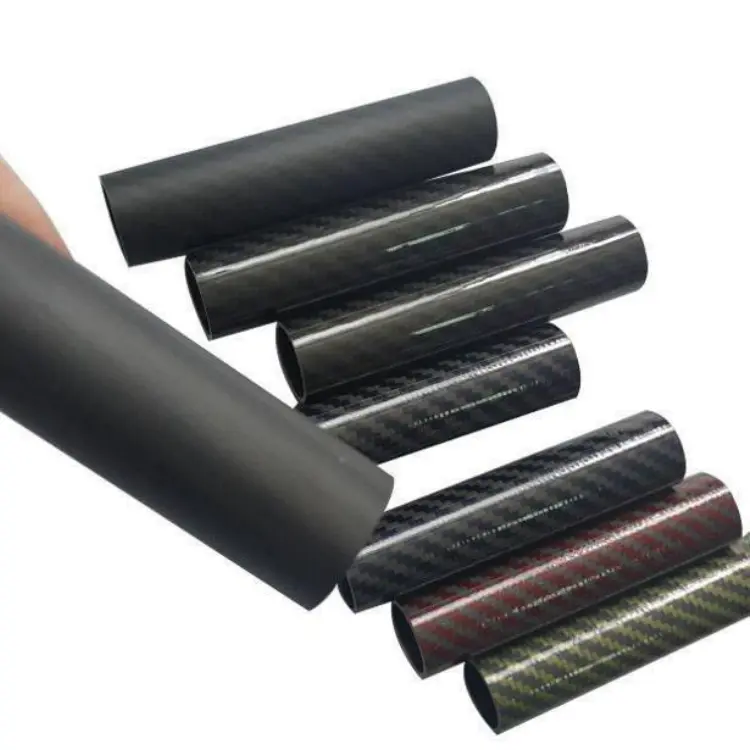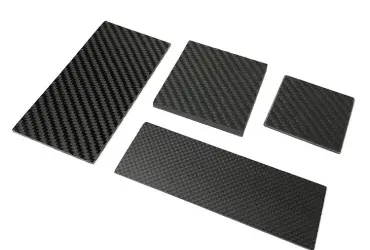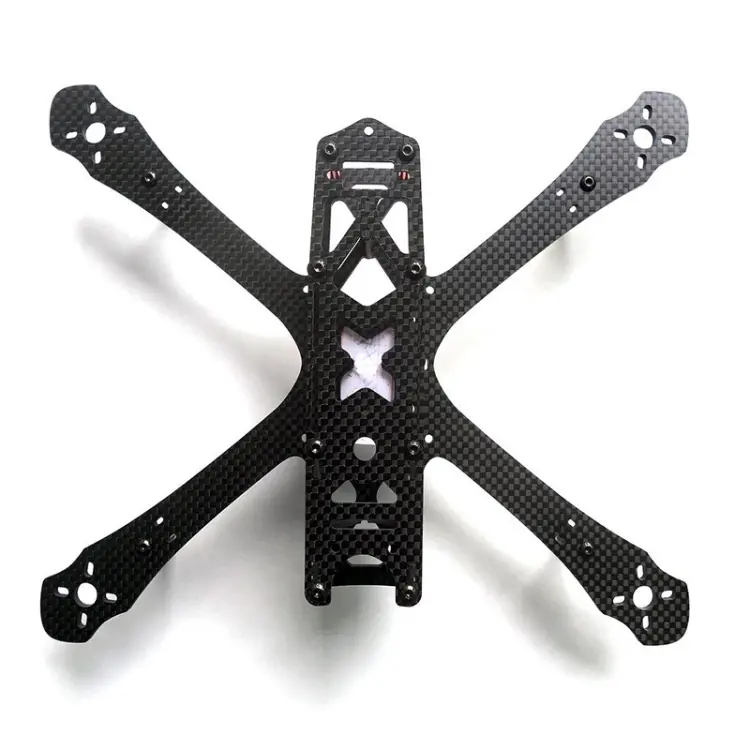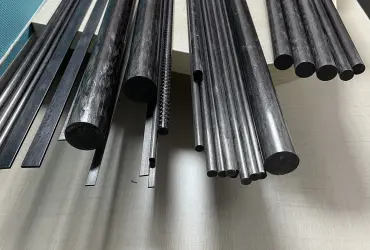1. Introduction
As demands for lightweight and high‑strength structures continue to rise, Carbon Fiber Round Tubes and aluminum tubes stand out as the two primary choices in engineering designs. The former—often called “black gold”—represents the pinnacle of composite technology, while the latter—the “silver classic”—embodies a century of refined metalworking. This article systematically compares their differences in material nature, mechanical properties, manufacturing processes, cost, and application scenarios, providing engineers, procurement decision‑makers, and enthusiasts with a clear selection roadmap.
2. Material Composition: Carbon Chains vs. Metal Crystals
Carbon Fiber Round Tubes
Constituents: Tens of thousands of 5–10 µm‑diameter carbon fibers (graphitic microcrystals) embedded in an epoxy (or polyester/phenolic) matrix, resulting in an anisotropic composite.
Structure: Axially aligned fibers deliver maximum longitudinal strength; interlaminar shear relies on the resin matrix. Strategic layup designs enable reinforcement precisely where needed.
Aluminum Tubes
Constituents: Aluminum alloy (e.g., 6061‑T6, 7075‑T6) with copper, magnesium, silicon additives forming a face‑centered cubic metal crystal—an isotropic material.
Structure: Uniform properties in all directions, but lacks the ability to tailor strength directionally through micro‑design.
3. Performance Face‑Off: Engineering Metrics
| Metric | High‑Modulus Carbon Fiber Tube (T700) | Aerospace‑Grade Aluminum Tube (7075‑T6) | Winner & Reason |
|---|---|---|---|
| Density | 1.6 g/cm³ | 2.8 g/cm³ | Carbon fiber is 42 % lighter |
| Axial Tensile Strength | 2000 MPa | 500 MPa | Carbon fiber is 4× stronger |
| Axial Modulus | 120–150 GPa | 70 GPa | Carbon fiber is ≈2× stiffer |
| Impact Toughness | Low (risk of delamination) | High (plastic deformation absorbs energy) | Aluminum tube wins |
| Fatigue Life | ≥10⁷ cycles (fiber‑dominated) | 10⁵–10⁶ cycles (crack propagation) | Carbon fiber excels |
| Thermal Conductivity | Low (insulator) | High (good conductor) | Aluminum tube wins |
| Coefficient of Thermal Expansion | ≈0 ×10⁻⁶/°C | 23 ×10⁻⁶/°C | Carbon fiber is nearly zero‑expansion |
Key Takeaways:
Weight Savings: In aerospace, each kilogram saved in a Carbon Fiber Round Tube can translate to tens of thousands of dollars in fuel savings.
Stiffness: A carbon fiber bicycle fork can boost pedaling stiffness by 30 % without increasing diameter—aluminum requires thicker walls and higher weight.
Failure Modes: Carbon fiber fails catastrophically without warning, whereas aluminum exhibits visible plastic deformation before collapse.

4. Manufacturing Processes: From Winding to CNC
Carbon Fiber Round Tubes
Core Processes: Prepreg filament winding with autoclave curing, or continuous pultrusion.
Challenges: Optimizing layup angles (0°/±45°/90°) via simulation; controlling void content below 2 % to maintain interlaminar shear strength.
Customization: One‑piece molding of complex cross‑sections (e.g., tapered tubes) reduces mechanical joints.
Aluminum Tubes
Processes: Extrusion (e.g., 6063‑T5) or CNC machining from solid billet.
Challenges: 7075 alloy requires T6 solution‑treatment and aging for hardness up to 150 HB; overheating can cause intergranular corrosion.
Limitations: Complex profiles need welding, creating weak zones with strength reductions up to 40 %.
5. Cost Analysis: From Raw Material to Lifecycle
Raw Material: Carbon fiber prepreg ≈ $50/kg vs. aluminum billet at ≈ $3/kg. Weight savings in Carbon Fiber Round Tubes can cut downstream operational costs (e.g., UAV endurance increases by 20 %).
Tooling: Composite molds may cost up to $10,000 for small batches, while aluminum extrusion dies cost ≈ $1,000.
Maintenance: Aluminum requires anodizing in marine environments (≈ $5 per piece); carbon fiber needs UV‑protective coatings (≈ $1 per piece).
6. Application Scenarios: Matching Needs to Materials
Prime Applications for Carbon Fiber Round Tubes
Aerospace: Satellite truss members (50 % weight reduction; operable at −150 °C).
High‑End Sports: Road bike forks absorbing vibration for enhanced ride feel.
Medical: CT gantry supports (X‑ray transmissivity >98 %, avoiding aluminum artifacts).
Irreplaceable Uses for Aluminum Tubes
Grounding Systems: Electrically conductive UAV landing gear.
High‑Temperature Zones: Engine mounts near 660 °C—carbon fiber resin matrix is limited to ≈ 150 °C.
Mass Production Cost‑sensitivity: Bike‑share frames at 100,000 units/month; carbon fiber cannot compete on price.
7. Selection Decision Tree
Is extreme weight reduction essential?
Yes → Carbon Fiber Round Tubes
No → Aluminum Tubes
Is impact toughness, conductivity, or high‑temperature resistance required?
Yes → Aluminum Tubes
No → Next question
Is budget able to absorb 3× material cost?
Yes → Carbon Fiber
No → Aluminum
8. Future Trends: Integration & Innovation
Hybrid Structures: Boeing 787 employs carbon fiber to aluminum‑lithium riveted joints, balancing weight and conductivity.
Recyclable Carbon Fiber: Thermoset resin depolymerization (e.g., ELG’s process) could reclaim scrap into recycled fiber, easing environmental impact.
Metal Matrix Composites: Aluminum reinforced with SiC particles is breaching 700 MPa tensile strength, poised to challenge composites in mid‑range markets.
9. Conclusion
Carbon Fiber Round Tubes and aluminum tubes are not mere substitutes but complementary tools in a materials engineer’s toolkit. The former surgically removes excess mass; the latter reliably performs under extreme conditions. Understanding their differences is ultimately an exercise in balancing performance, cost, and application context. In the next wave of lightweight innovation, the real question won’t be “either/or,” but “when to use carbon, where to use aluminum.”





